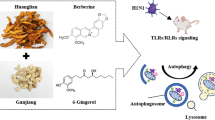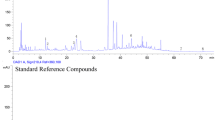Abstract
Background
The H1N1 influenza virus causes acute respiratory tract infection, and its clinical symptoms are very similar to those of ordinary influenza. The disease develops rapidly. If the flu is not treated, complications such as pneumonia, respiratory failure, and multiple organ damage can occur, resulting in a high fatality rate. Influenza virus mutates rapidly. At present, there is no specific drug for H1N1, so it is an urgent need for clinical care to find new drugs to treat H1N1.
Materials and methods
The polysaccharide derived from Durvillaea Antarctica green algae has a certain antiviral effect. In this study, the results of CCK-8, apoptosis cycle detection, JC-1 and Western blotting proved that Duvira Antarctic polysaccharide (DAPP) has the ability to inhibit H1N1 infection.
Results
CCK-8 test showed that the DAPP with concentration at 32 μg/mL had no toxicity to MDCK cells. In addition, DAPP reduced cell apoptosis by inhibiting the ERK signaling pathway. Meanwhile, DAPP could increase the expression of STAT3 and significantly inhibited proinflammatory cytokines.
Conclusions
In summary, these results suggested that DAPP may be potential with the ability to resist the H1N1 influenza virus.





Similar content being viewed by others
Data availability
Data sharing not applicable to this article as no datasets were generated or analysed during the current study.
References
Yang M, Sunderland K, Mao C (2017) Virus-derived peptides for clinical applications. Chem Rev 117:10377–10402. https://doi.org/10.1021/acs.chemrev.7b00100
Alaraji F, Muhsen H, Alhatami AO, Khudhair YI (2019) Macedonian veterinary review identification the presence of clade 2.3.2.1c-avian influenza H5N1, a highly pathogenic virus in Iraq, 2018. Maced Vet Rev 42:i–vi. https://doi.org/10.2478/macvetrev-2019-0024
Adabor ES (2019) Anticipating time-dependent antigenic variants of influenza A (H3N2) viruses. Infect Genet Evol 67:67–72. https://doi.org/10.1016/j.meegid.2018.10.028
Liu YJ, Zhang LQ, Wei W, Zhao HY, Zhou ZX, Zhang YJ, Liu SQ (2015) Colorimetric detection of influenza A virus using antibody-functionalized gold nanoparticles. Analyst 140:3989–3995. https://doi.org/10.1039/c5an00407a
Chlanda P, Mekhedov E, Waters H, Sodt A, Schwartz C, Nair V, Blank PS, Zimmerberg J (2017) Palmitoylation contributes to membrane curvature in influenza A virus assembly and hemagglutinin-mediated membrane fusion. J Virol 91:e00947-e1017. https://doi.org/10.1128/jvi.00947-17
Londrigan SL, Short KR, Ma J, Gillespie L, Rockman SP, Brooks AG, Reading PC (2015) Infection of mouse macrophages by seasonal influenza viruses can be restricted at the level of virus entry and at a late stage in the virus life cycle. J Virol 89:12319–12329. https://doi.org/10.1128/jvi.01455-15
Loveday EK, Diederich S, Pasick J, Jean F (2015) Human microRNA-24 modulates highly pathogenic avian-origin H5N1 influenza A virus infection in A549 cells by targeting secretory pathway furin. J Gen Virol 96:30–39. https://doi.org/10.1099/vir.0.068585-0
Krammer F (2016) Novel universal influenza virus vaccine approaches. Curr Opin Virol 17:95–103. https://doi.org/10.1016/j.coviro.2016.02.002
Yuan D, Li C, Huang Q, Fu X, Dong H (2022) Current advances in the anti-inflammatory effects and mechanisms of natural polysaccharides. Crit Rev Food Sci Nutr 12:1–21. https://doi.org/10.1080/10408398.2022.2025535
Bilal M, Iqbal HMN (2020) Marine seaweed polysaccharides-based engineered cues for the modern biomedical sector. Mar Drugs 18:7. https://doi.org/10.3390/md18010007
Jamie C, Zhang J, Jeff N, Bachar B, Cheng Z (2018) Seaweed extract (Stella Maris) activates innate immune responses in Arabidopsis thaliana and protects host against bacterial pathogens. Mar Drugs 16:221. https://doi.org/10.3390/md16070221
Geetha Bai R, Tuvikene R (2021) Potential antiviral properties of industrially important marine algal polysaccharides and their significance in fighting a future viral pandemic. Viruses 13:1817. https://doi.org/10.3390/v13091817
Changbing W, Haiyang C, Danyang C, Mingqi Z, Zhengfang L, Min G, Tiantian X, Yi C, Liang H, Tao L, Ying T, Bing Z, Yinghua L (2020) The inhibition of H1N1 influenza virus-induced apoptosis by surface decoration of selenium nanoparticles with β-thujaplicin through reactive oxygen species-mediated AKT and p53 signaling pathways. ACS Omega 5:30633–30642. https://doi.org/10.1021/acsomega.0c04624
Kim J, Yeom M, Lee T, Kim H-O, Na W, Kang A, Lim J-W, Park G, Park C, Song D, Haam S (2020) Porous gold nanoparticles for attenuating infectivity of influenza A virus. J Nanobiotechnol 18:54. https://doi.org/10.1186/s12951-020-00611-8
Li YH, Lin ZF, Zhao MQ, Guo M, Xu TT, Wang CB, Xia HM, Zhu B (2016) Reversal of H1N1 influenza virus-induced apoptosis by silver nanoparticles functionalized with amantadine. RSC Adv 6:89679–89686. https://doi.org/10.1039/c6ra18493f
Zou J, Zhu B, Li Y (2020) Functionalization of silver nanoparticles loaded with paclitaxel-induced A549 cells apoptosis through ROS-mediated signaling pathways. Curr Top Med Chem 20:89–98. https://doi.org/10.2174/1568026619666191019102219
Burgess K, Rankin N (2021) Metabolomics for the diagnosis of influenza. EBioMedicine 72:103599. https://doi.org/10.1016/j.ebiom.2021.103599
Lin Z, Li Y, Gong G, Xia Y, Wang C, Chen Y, Hua L, Zhong J, Tang Y, Liu X, Zhu B (2018) Restriction of H1N1 influenza virus infection by selenium nanoparticles loaded with ribavirin via resisting caspase-3 apoptotic pathway. Int J Nanomed 13:5787–5797. https://doi.org/10.2147/ijn.S177658
Guo M, Li Y, Lin Z, Zhao M, Xiao M, Wang C, Xu T, Xia Y, Zhu B (2017) Surface decoration of selenium nanoparticles with curcumin induced HepG2 cell apoptosis through ROS mediated p53 and AKT signaling pathways. RSC Adv 7:52456–52464. https://doi.org/10.1039/c7ra08796a
Li Y, Lin Z, Guo M, Zhao M, Xia Y, Wang C, Xu T, Zhu B (2018) Inhibition of H1N1 influenza virus-induced apoptosis by functionalized selenium nanoparticles with amantadine through ROS-mediated AKT signaling pathways. Int J Nanomed 13:2005–2016. https://doi.org/10.2147/ijn.S155994
Li Y, Lin Z, Zhao M, Xu T, Wang C, Hua L, Wang H, Xia H, Zhu B (2016) Silver nanoparticle based codelivery of oseltamivir to inhibit the activity of the H1N1 influenza virus through ROS-mediated signaling pathways. ACS Appl Mater Interfaces 8:24385–24393. https://doi.org/10.1021/acsami.6b06613
Lin Z, Li Y, Guo M, Xu T, Wang C, Zhao M, Wang H, Chen T, Zhu B (2017) The inhibition of H1N1 influenza virus-induced apoptosis by silver nanoparticles functionalized with zanamivir. RSC Adv 7:742–750. https://doi.org/10.1039/c6ra25010f
Xia Y, Xu T, Wang C, Li Y, Lin Z, Zhao M, Zhu B (2018) Novel functionalized nanoparticles for tumor-targeting co-delivery of doxorubicin and siRNA to enhance cancer therapy. Int J Nanomed 13:143–159. https://doi.org/10.2147/ijn.S148960
Ling LJ, Lu Y, Zhang YY, Zhu HY, Tu P, Li H, Chen DF (2020) Flavonoids from Houttuynia cordata attenuate H1N1-induced acute lung injury in mice via inhibition of influenza virus and toll-like receptor signalling. Phytomedicine 67:153150. https://doi.org/10.1016/j.phymed.2019.153150
Zhao MQ, Wang LH, Lian GW, Lin ZF, Li YH, Guo M, Chen Y, Liu XM, Zhu B (2020) Characterization of lymphocyte subsets in peripheral blood cells of children with EV71 infection. J Microbiol Immunol Infect 53:705–714. https://doi.org/10.1016/j.jmii.2019.03.001
Xu T, Li Y, Wu HL, Chen H, Wu H, Guo M, Zhao M, Wang C, Lin T, Lin Z, Chen D, Xiang W, Zhu B (2021) The inhibition of enterovirus 71 induced apoptosis by Durvillaea antarctica through P53 and STAT1 signaling pathway. J Med Virol 93:3532–3538. https://doi.org/10.1002/jmv.26693
Kerr J, Macartney K, Britton PN (2021) Influenza-associated myositis: a single-centre, 5-year retrospective study. Eur J Pediatr 180:577–584. https://doi.org/10.1007/s00431-020-03835-w
Li Y, Lin Z, Guo M, Xia Y, Zhao M, Wang C, Xu T, Chen T, Zhu B (2017) Inhibitory activity of selenium nanoparticles functionalized with oseltamivir on H1N1 influenza virus. Int J Nanomed 12:5733–5743. https://doi.org/10.2147/ijn.S140939
Laurie KL, Rockman S (2021) Which influenza viruses will emerge following the SARS-CoV-2 pandemic? Influenza Other Respir Viruses 15:573–576. https://doi.org/10.1111/irv.12866
Enkhtaivan G, Muthuraman P, Kim DH (2017) Inhibitory effect of 2,4-dichlorophenoxyacetic acid on ROS, autophagy formation, and mRNA replication for influenza virus infection. J Mol Recognit 30:1–10. https://doi.org/10.1002/jmr.2616
Motawi TK, Shahin NN, Maghraby AS, Kirschfink M, Nadeem Abd-Elshafy D, Awad K, Bahgat MM (2020) H1N1 infection reduces glucose level in human U937 monocytes culture. Viral Immunol 33:384–390. https://doi.org/10.1089/vim.2019.0163
Khalil AM, Yoshida R, Masatani T, Takada A, Ozawa M (2021) Variation in the HA antigenicity of A(H1N1)pdm09-related swine influenza viruses. J Gen Virol. https://doi.org/10.1099/jgv.0.001569
Ren L, Zhang W, Zhang J, Zhang J, Zhang H, Zhu Y, Meng X, Yi Z, Wang R (2021) Influenza A virus (H1N1) infection induces glycolysis to facilitate viral replication. Virol Sin 36:1532–1542. https://doi.org/10.1007/s12250-021-00433-4
Sarkanen TO, Alakuijala APE, Dauvilliers YA, Partinen MM (2018) Incidence of narcolepsy after H1N1 influenza and vaccinations: systematic review and meta-analysis. Sleep Med Rev 38:177–186. https://doi.org/10.1016/j.smrv.2017.06.006
Lv DQ, Li HY, Wu XM, Lin L, Yan SQ, Guo QY (2020) MiR-188 inhibits proliferation and promotes apoptosis of lung adenocarcinoma cells by targeting SIX1 to negatively regulate ERK signaling pathway. Eur Rev Med Pharmacol Sci 24:721–727. https://doi.org/10.26355/eurrev_202001_20051
Singh R, Banerjee C, Ray A, Rajamani P, Mazumder S (2016) Fluoride-induced headkidney macrophage cell apoptosis involves activation of the CaMKIIg-ERK 1/2-caspase-8 axis: the role of superoxide in initiating the apoptotic cascade. Toxicol Res 5:1477–1489. https://doi.org/10.1039/c6tx00206d
Acknowledgements
This work was supported by the Guangdong Natural Science Foundation (2020A1515110648), the Open Fund of Guangdong Provincial Key Laboratory of Functional Supramolecular Coordination Materials and Applications (2020A03), Technology Planning Project of Guangzhou (202102010202). Open Project of Guangdong Key Laboratory of Marine Materia Medica (LMM2020-7). The Guangzhou Medical University Students’ Science and Technology Innovation Project (2020AEK03, 2021AEK119, 2021AEK122, 2021AEK125 and 2021AEK128).
Funding
This work was supported by the Guangdong Natural Science Foundation (2020A1515110648), the Open Fund of Guangdong Provincial Key Laboratory of Functional Supramolecular Coordination Materials and Applications (2020A03), Technology Planning Project of Guangzhou (202102010202). Open Project of Guangdong Key Laboratory of Marine Materia Medica (LMM2020-7). The Guangzhou Medical University Students’ Science and Technology Innovation Project (2020AEK03, 2021AEK119, 2021AEK122, 2021AEK125 and 2021AEK128).
Author information
Authors and Affiliations
Contributions
JS, DC and RZ designed the study, analyzed the experimental data and drafted the manuscript. XL and MZ carried out the experiments. BZ and YL refined the manuscript. All authors read and approved the final manuscript.
Corresponding authors
Ethics declarations
Conflict of interest
The authors declare no competing financial interest.
Additional information
Publisher's Note
Springer Nature remains neutral with regard to jurisdictional claims in published maps and institutional affiliations.
Rights and permissions
About this article
Cite this article
Su, J., Chen, D., Zheng, R. et al. Duvira Antarctic polysaccharide inhibited H1N1 influenza virus-induced apoptosis through ROS mediated ERK and STAT-3 signaling pathway. Mol Biol Rep 49, 6225–6233 (2022). https://doi.org/10.1007/s11033-022-07418-w
Received:
Accepted:
Published:
Issue Date:
DOI: https://doi.org/10.1007/s11033-022-07418-w




